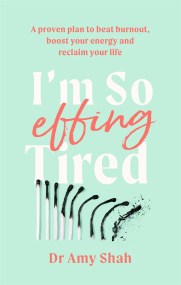How to avoid burnout with intermittent fasting

You may have heard a lot about intermittent fasting because, well, it seems like everyone — your trainer, your child’s teacher, heck, even your dentist — is trying it. Intermittent fasting is when you eat all of your food for the day within a specific window of time, often a 10-hour window (such as 10 a.m. to 8 p.m.) or an 8-hour window (such as 12 p.m. to 8 p.m.). Sometimes it means limiting your food to one meal a day. There are a lot of different variations, some better than others. My program — what I like to call circadian fasting — is different than a typical intermittent fasting diet because it works in sync with your body’s natural clock.
What is circadian fasting?
Giving our bodies a rest from food can be very beneficial to our overall health, and ‘gut rest’ is exactly that — you are giving your gut a much-needed rest. This means you stop eating 2–3 hours before bed and fast until late in the morning. There have been a plethora of studies that show that eating in this window (late morning to early evening/late afternoon) is super beneficial to our insulin levels and sleep. And, as we know, good sleep helps the body reboot and repair itself. For example, studies show that for every 3-hour increase in nighttime fasting, there was a 4 percent reduction in glucose. This means that if we stop eating 3 hours before bed, we’ll be rewarded over the long term with less diabetes, heart disease and obesity.
Intermittent fasting (IF) cheat sheet
- The best type of intermittent fasting for a busy person, in my opinion, is circadian fasting, which means eating for an 8- to 10-hour window during the day. If you are new to IF, then start slow, fasting for 12 hours and eating for 12 hours. There are no hard rules, except that you need to respect and listen to your body.
- Cycle your fast. If I fast for 12 hours one day, then I switch it to 14 or 16 hours the next. I find that it’s kinder to my hormones and less stressful.
- Try to cluster most of your calories from 12 p.m. to 5 p.m. Try not to eat within 3 hours of bedtime, and do not overeat during your eating window. Plan your meals and eating times in advance. A good guide is to break your fast with something small between 8 and 10 a.m., with lunch at 12 and then dinner between 3 and 6, if your schedule allows.
- Nutrient-dense foods are best: nuts, seeds, fruits (berries), vegetables, lean protein (sprouted tofu), whole grains, beans. Focus on eating high-fibre, unprocessed, whole foods. Avoid meat as much as possible, especially red meat, sugar, trans fats and refined starches.
- If you get hungry during your fasting period, try to curb your hunger with water or non-caloric drinks (such as coffee and tea). If your hunger does not dissipate, then eat something that is sugar-free and is 40 calories or less, such as a spoonful of peanut butter, a thin slice of avocado, or a handful of nuts.
- Fasted workouts, where you work out at the end of the fasting period, will give you the best chance to get the full metabolic benefits of fasting, such as metabolic switching. It also ramps up the autophagy (‘self-eating’) mode, which is so regenerating. Time a meal to follow a moderate to aggressive workout. (Some people cannot exercise on an empty stomach, so if that is the case, eat first, then exercise.)
- Stay hydrated while fasting. Drink 2.25– 2.75 litres of water per day.
- Constantly check in with your body. If your answer to any of these questions is concerning, stop your fast and check in with your doctor: Is your energy stable? Are your periods regular, or are you missing or having irregular periods? How are your cravings and hunger? How are you sleeping?
- Intermittent fasting is not a ‘lose weight quick’ scheme. You need to have the right mindset for IF. Make sure you have clear and concise objectives for your fasting program.
- Get plenty of rest. Sleep a minimum of 7 hours per night (if not more). Also, a 20-minute catnap during the day can do wonders for your body. If you can squeeze in a quick nap, take advantage and recharge.
4 mistakes made while intermittent fasting
Look, it is easy to make rookie mistakes when you first start fasting — I certainly did! And there are times that cravings will come into play. Here are a few tips on what to avoid and to keep yourself on track:
- People go too long, too hard. Since you are literally starving your body, if your body is not used to it, IF will result in fatigue and cravings, and can negatively affect your hormones.
- People don’t decrease their sugar intake. If you fast and then eat too much sugar during the eating window, your body will start on a sugar-and-carb roller coaster that will negatively affect how it functions, giving you a case of the jitters along with hunger pangs and cravings.
- People give in to cravings while fasting and go overboard and eat too much. If you are in a fasting window, try a 40-calorie snacks (such as a spoonful of peanut butter, a thin slice of avocado, or a handful of nuts.) to stave off those pangs.
- People don’t personalise the fast, neglecting to take into account individual health needs, such as chronic issues, pregnancy, gender, and age.
-
Exhaustion doesn't have to be your new normal
Are you feeling overwhelmed, overstressed, and overtired? If so, you're not alone - and you don't have to settle for feeling this way. Inspired by her personal wellness journey, Dr. Amy Shah has created this program so that you can regain your energy and reclaim your life. The key is tapping into the powerful energy trifecta: the complex, interconnected relationship between your gut, your immune system, and your hormones. Drawing on the latest science and her work helping thousands of clients, Dr. Shah explains how to transform your life by changing:
What You Eat: increase your fiber-rich, prebiotic vegetables, without giving up your wine and chocolate!?
When You Eat: intermittent fasting - the right way - can revamp your energy
Why You're Stressed: discover simple exercises and herbs that ease anxiety
In just two weeks, you'll feel your energy surge. In three months, you'll feel like a whole new person. It's time to regain the energy you've lost, so you can get back to the life you want to live.





